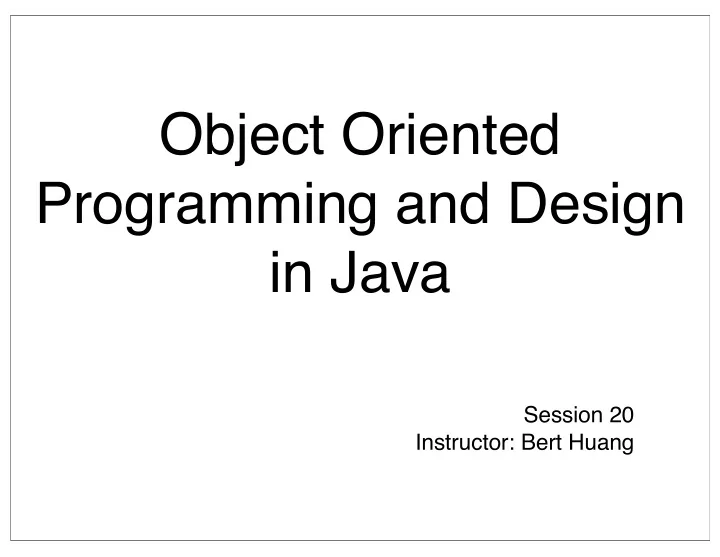

Object Oriented Programming and Design in Java Session 20 Instructor: Bert Huang
Announcements • Homework 4 due Monday, Apr. 19th ( next class)
Review • Homework tips • Data Structures • Lists, Stacks, Queues • Sets, HashSet • Maps, HashMap
Today ʼ s Plan • Applications of queues, stacks, maps, sets • Binary search trees • Priority Queues (Heaps)
Summary remove remove at contains insert insert at lists O(1) O(N) O(1) O(N) O(N) stacks/ O(1) X O(1) X X queues set O(1) X O(1) X O(1) map O(1) ~O(1) O(1) ~O(1) O(1)
Data Type Applications • Abstract Data Types allow well- organized design of data applications • Design in terms of ADTs, most environments provide efficient implementations of standard ADTs • Know which ADTs and data structures apply in different situations
Producer Consumer Queues requests service • Web server receives http requests from browsers, puts request in queue • Other threads remove from the queue, serve web pages to browsers • Using a queue guarantees O(1) operations and first-come-first-serve scheduling
Deques • A deque is a queue and a stack • Insert and remove from either head or tail • addFirst(e), addLast(e), getFirst(), getLast() • ArrayDeque<E> implements Queue<E> • LinkedList<E> implements Queue<E> and Deque<E>
Stacks for Method Calls • When method is called, parameters and variables in its scope are pushed • Once it is evaluated, it is popped next() • Nested method calls populate a stack println() System.out.println(scanner.next()) • Too many nested calls causes stack overflow, JVM out of memory runForever() public void runForever() { runForever() runForever(); } runForever() runForever() runForever()
Web Search by Word Sets cat • Documents can be represented fish as sets of keywords pet • Search for keywords by calling fish contains() on each document rice • contains() and adding new chopsticks document must be fast • search O(1) per document chopsticks deadlock • new document O(k) for k words threads
Word Counting with Maps • Natural extension to storing documents as word sets: word counts • Each word maps to an integer count HashMap<String, Integer> • Scan through document, increment count for each word to be or not • “to be or not to be” 1 +1 1 +1 1 1 • O(1) per word in document
Sorted Map ADT • Subtype of Map (can get value by key) • SortedMap<K implements Comparable,V> • SortedMap<K,V> subMap(K fromKey, K toKey) • firstKey, lastKey, headMap, tailMap
TreeMap • Implements SortedMap • put(), get(), contains() cost O(log N) • Uses an advanced binary search tree called Red-Black Tree • a balanced BST • Slower than HashMap, but keys have order
Binary Search Tree • Tree nodes have left and right children • Left children are less than parent, 7 • Right children are greater than parent 5 10 • At each node, O(1) comparison 2 6 15 determines which child to move to • Depth of tree is the worst-case time for 12 each operation
Due Dates with BST • A calendar or to-do list program may store due dates in a BST • Allows efficient search for date ranges • What ʼ s due from today to Monday? • Show me things due after Monday
Priority Queue ADT • Stores elements by priority (serves as the key) • Not really a queue, but used in similar applications • add aka offer(E e) • deleteMin aka poll() • findMin aka peek()
Heaps • Binary tree with heap order property: keys of children greater than parent ʼ s • Running time: 2 • O(log N) add, 5 10 • O(log N) deleteMin, 7 6 40 11 • O(1) findMin
Comparison insert findMin get get range lists O(1) O(N) O(N) X hashmap O(1) O(N) O(1) X BST O(log N) O(log N) O(log N) O(N) heap O(log N) O(1) O(N) X
Producer Consumer with Priority Queues • Natural extension to using a simple queue, assign priority to all requests • Consumer grabs the highest (lowest) priority element service • Is it worth the log N overhead? Depends on application • If consuming is very fast, skip the fancy prioritization and just do it fast requests
Thread Safe Data Structures • Since data structures are designed to be extremely fast, thread safety is omitted to avoid overhead • Java has interface ConcurrentMap, implemented by ConcurrentHashMap • and interface BlockingQueue, implemented by ArrayBlockingQueue, LinkedBlockingQueue
Threadsafe Wrappers • Collections has static method Collection synchronizedCollection(Collection c) • returns synchronized wrapper of c • synchronizedSet, List, Map, SortedMap • Returns decorated object of anonymous class • Each unsafe method is wrapped with an object lock
Reading • http://java.sun.com/docs/books/tutorial/ collections/implementations/index.html
Recommend
More recommend